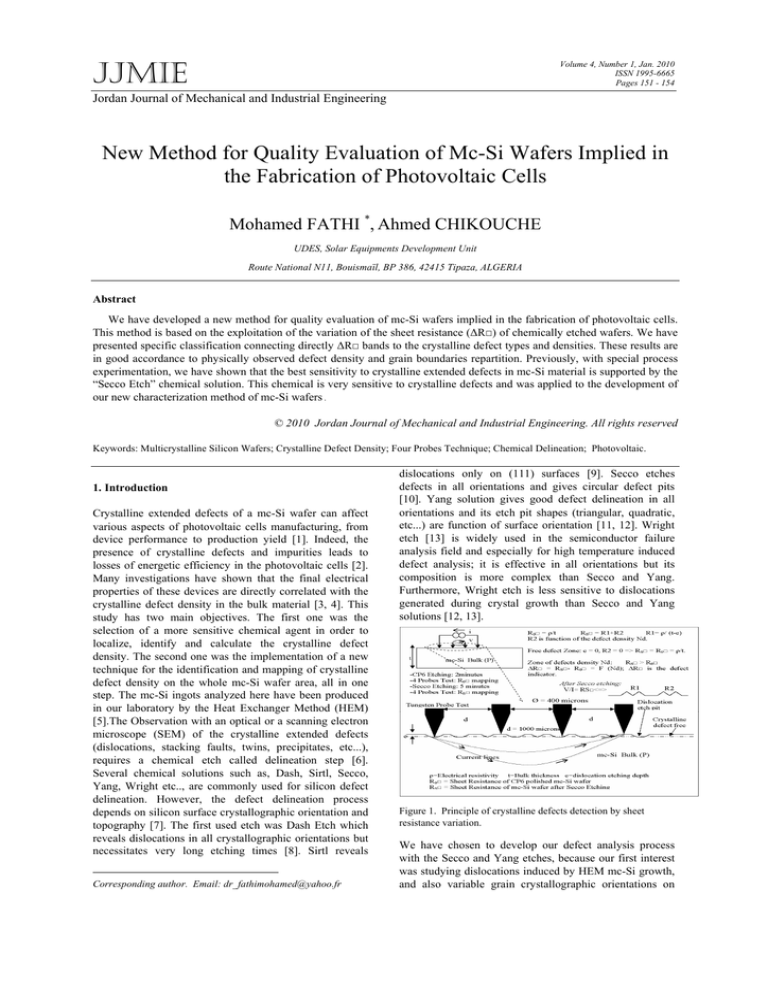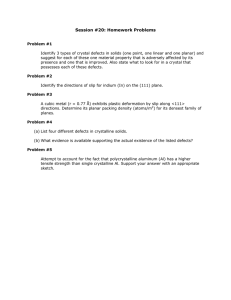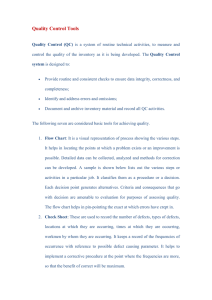
JJMIE
Volume 4, Number 1, Jan. 2010
ISSN 1995-6665
Pages 151 - 154
Jordan Journal of Mechanical and Industrial Engineering
New Method for Quality Evaluation of Mc-Si Wafers Implied in
the Fabrication of Photovoltaic Cells
Mohamed FATHI *, Ahmed CHIKOUCHE
UDES, Solar Equipments Development Unit
Route National N11, Bouismaïl, BP 386, 42415 Tipaza, ALGERIA
Abstract
We have developed a new method for quality evaluation of mc-Si wafers implied in the fabrication of photovoltaic cells.
This method is based on the exploitation of the variation of the sheet resistance (ΔR□) of chemically etched wafers. We have
presented specific classification connecting directly ΔR□ bands to the crystalline defect types and densities. These results are
in good accordance to physically observed defect density and grain boundaries repartition. Previously, with special process
experimentation, we have shown that the best sensitivity to crystalline extended defects in mc-Si material is supported by the
“Secco Etch” chemical solution. This chemical is very sensitive to crystalline defects and was applied to the development of
our new characterization method of mc-Si wafers .
© 2010 Jordan Journal of Mechanical and Industrial Engineering. All rights reserved
Keywords: Multicrystalline Silicon Wafers; Crystalline Defect Density; Four Probes Technique; Chemical Delineation; Photovoltaic.
1. Introduction
*
Crystalline extended defects of a mc-Si wafer can affect
various aspects of photovoltaic cells manufacturing, from
device performance to production yield [1]. Indeed, the
presence of crystalline defects and impurities leads to
losses of energetic efficiency in the photovoltaic cells [2].
Many investigations have shown that the final electrical
properties of these devices are directly correlated with the
crystalline defect density in the bulk material [3, 4]. This
study has two main objectives. The first one was the
selection of a more sensitive chemical agent in order to
localize, identify and calculate the crystalline defect
density. The second one was the implementation of a new
technique for the identification and mapping of crystalline
defect density on the whole mc-Si wafer area, all in one
step. The mc-Si ingots analyzed here have been produced
in our laboratory by the Heat Exchanger Method (HEM)
[5].The Observation with an optical or a scanning electron
microscope (SEM) of the crystalline extended defects
(dislocations, stacking faults, twins, precipitates, etc...),
requires a chemical etch called delineation step [6].
Several chemical solutions such as, Dash, Sirtl, Secco,
Yang, Wright etc.., are commonly used for silicon defect
delineation. However, the defect delineation process
depends on silicon surface crystallographic orientation and
topography [7]. The first used etch was Dash Etch which
reveals dislocations in all crystallographic orientations but
necessitates very long etching times [8]. Sirtl reveals
Corresponding author. Email: dr_fathimohamed@yahoo.fr
dislocations only on (111) surfaces [9]. Secco etches
defects in all orientations and gives circular defect pits
[10]. Yang solution gives good defect delineation in all
orientations and its etch pit shapes (triangular, quadratic,
etc...) are function of surface orientation [11, 12]. Wright
etch [13] is widely used in the semiconductor failure
analysis field and especially for high temperature induced
defect analysis; it is effective in all orientations but its
composition is more complex than Secco and Yang.
Furthermore, Wright etch is less sensitive to dislocations
generated during crystal growth than Secco and Yang
solutions [12, 13].
Figure 1. Principle of crystalline defects detection by sheet
resistance variation.
We have chosen to develop our defect analysis process
with the Secco and Yang etches, because our first interest
was studying dislocations induced by HEM mc-Si growth,
and also variable grain crystallographic orientations on
152
© 2010 Jordan Journal of Mechanical and Industrial Engineering. All rights reserved - Volume 4, Number 1 (ISSN 1995-6665)
mc-Si material. Both etching solutions are sensitive to all
kind of crystalline defects and also to all crystallographic
orientations. The specificity of mc-Si HEM material has
necessitated a special adjustment of Yang and Secco
etching process parameters (time, agitation, temperature,
etc…).
The principle of the developed technique for the mapping
of crystalline defects is based on the exploitation of the
sheet resistance variation in the delineated zones of
crystalline defects. The delineation process consists of the
action of a selective etching agent which will attack more
quickly the crystalline defected zones than the other zones.
This is due to the fact that in defected regions, the
disturbance of the crystal lattice causes weak atomic
bonds. The decoration of defect will take place only on the
crystal grains levels; the zones of grain boundaries will be
uniformly and more quickly etched than the grain surface
because the atomics bonds are too weak there. Thus, the
measurement of sheet resistance on the etched area should
indicate a variation compared to the initial value obtained
before application of the delineation solution on the wafer.
A more defected area should lead to a higher increase in
sheet resistance. In order to obtain a significant increase of
sheet resistance, it is important to cause major perforations
at the defect sites. Therefore, longer etching times than
used for SEM defect inspection are necessary.
This new concept for crystalline defect mapping would
provide time reduction and easy automation for defects
analysis. It would be applied for the study of the defect
density variation with the wafer position along the ingot. It
would also be useful for the control of defects induced by
each processing step during photovoltaic device
manufacturing.
The sheet resistance measurement technique and
crystalline defects delineation are both well established
techniques in semiconductor characterization field.
However, the combination of these two techniques for
mapping crystalline defects is a new and useful approach.
Indeed, in comparison to other techniques such as
automated light scattering [14] or Sopori scanning
machine [15], our technique is more economic in terms of
time and cost. It is also more adapted for a first diagnostic
to make a qualitative and fast study of the defect
(SiO2) and then rinsed in deionized water. The Secco [10]
formulation is HF/potassium bichromate (K2Cr2O7)/H2O,
obtained by mixing 2 parts of HF with 1 part of
K2Cr2O7/H2O at (0.15Moles) or (44grams of K2Cr2O7 in
1litre of H2O). The Yang [11] formulation is HF/chromic
acid (CrO3)/H2O, obtained by mixing 1 part of HF with 1
part of CrO3/H2O at (1.5Moles) or (150grams of CrO3 in
1litre of H2O). After the Secco or Yang etching process
the samples were immediately rinsed in deionized water
and nitrogen dried. Subsequently, SEM observation and
other analysis have been performed.
For the development and study of defect density
mapping technique, we have used a mc-Si wafer
previously polished by “CP4 Etch”, with a final thickness
of about 325µm (±5µm). By using an automated four
probes tester, we have measured the sheet resistance at 25
different positions which were well defined and regularly
distributed across the wafer surface. Stamp marks were
applied on the probe tester carrier as a reference to allow
positioning of the wafer exactly at the same place during
the next measurement step (following the crystalline
defects etching). Once the sheet resistance mapping of the
polished mc-Si wafer was over, we carried out a
desoxidation of the wafer with HF (10%) during 30
seconds followed by water rinsing. Then, we proceeded to
the delineation of the crystalline defects. For this step, we
have chosen to apply “Secco Etch” during 5 minutes. The
etched mc-Si wafer by Secco solution was then precisely
positioned under the 4 probe tester, and the sheet
resistance was measured again at the same 25 initially
selected positions. Thereafter, we calculate and plot the
sheet resistance variation (ΔR□) mapping. This result and
its correlation is presented and discussed below. Figure 1
is a typical representation of this developed technique.
Dislocation
Etched Pit
Twin
Dislocation
line
2. Experimental
We have used P-type Boron doped mc-Si wafers of 10
x 10 cm2 in dimension and of about 1 Ω.cm in electrical
resistivity. They were sawed from ingots grown by the
Heat Exchanger Method (HEM). In order to remove the
sawing process damage, we have begun by thinning and
polishing these wafers. During this step, we have used an
acidic polishing solution (known as “CP4 Etch”) made by
mixing nitric acid (HNO3), acetic acid (CH3COOH) and
hydrofluoric acid (HF) with respectively 50%, 30% and
20% concentrations. After 6 min of etching, we rinsed
thoroughly the mc-Si wafers with deionized water and
dried them under a nitrogen gun. In order to test the Secco
and Yang solutions, samples were cut from a polished mcSi wafer. Mainly, the etching time and the agitation mode
were varied. Before each delineation trial, the samples
were immersed in diluted HF (10%) solution for 30
seconds in order to remove the native silicon dioxide
Figure 2. Secco defects delineation on mc-Si
3. Results and Discussion
The results of Yang and Secco delineation studies confirm
the revelation of crystalline defects for an immersion time
from 1 to 2 minutes, by clearly delineating dislocations,
twins, grain boundaries and dislocation lines. We observed
that dislocation pits etched with the Yang solution have
mainly triangular or quadratic forms, whereas the
dislocation pits are circular when using the Secco solution.
Figure 2 is an illustration of Secco defect delineation
process under the optimized conditions.
© 2010 Jordan Journal of Mechanical and Industrial Engineering. All rights reserved - Volume 4, Number 1 (ISSN 1995-6665)
153
Perfect
Silicon
ΔR□
Delineate
Dislocation
Value
Figure 3. Cross section of dislocation delineated by Secco Etch for
5 minutes
In order to compare the action of dislocation localization
between Secco and Yang solutions, we carried out a Secco
revelation on a sample previously revealed with Yang Etch
and vice-versa. The aim was to enable us to make a choice
between Secco and Yang Etches for the calculation of the
maximum density of defects. These tests showed that the
action of Secco is higher than Yang’s and lead us to
choose Secco for the calculation and mapping of
dislocation density. The profile of etched dislocation pits
revealed by this solution is shown on Figure 3. The
dipping time of the Secco delineation process was fixed at
5 minutes for the following defect mapping study. Such
dipping time removes 5 µm of the dislocation zone as
shown by the SEM micrograph of Figure 3. This fine
knowledge and control of crystalline defect decoration by
“Secco Etch” on mc-Si wafers were directly applied to the
development of defect detection by the sheet resistance
variation technique.
Once the sheet resistance mapping of a polished mc-Si
wafer (10x10 cm2) was completed, we submitted the
wafer to a Secco etch during 5 minutes. We chose this
revelation time in order to strongly mark the defected
zones and thus obtain an appreciable variation of sheet
resistance. The mc-Si wafer revealed in this way was then
precisely placed under the 4 probes tester, and
measurement of the sheet resistance was carried out at the
initially selected positions. We plotted the mapping of
sheet resistance variation (ΔR□) on the 25 selected points
of the mc-Si wafer. The Figure 4 shows the layout
obtained for ΔR□. The next step was the superposition of
the physical image of decorated mc-Si wafer with that of
the ΔR□ mapping. In order to accomplish this, we have
taken a digitalized photo of the whole Secco etched wafer
surface, scaled it, and finally successfully superposed it to
ΔR□ mapping. The Figure 4 illustrates this original result.
The SEM analysis of these results allowed us to make the
first classification for ΔR□ bands according to the revealed
crystalline defect type and average dislocation density.
This classification is summarized on Table 1.
Figure 4. Superposition of the physical image of the defects area
with ΔR□ mapping
Finally, by using this interesting correlation between sheet
resistance variation (ΔR□) and defect density, we have
plotted the mapping of the average defects density
mapping on a whole mc-Si wafer (see Figure 5). These
mapped values are in good agreements with those obtained
from SEM analysis by counting etch pits. Sheet resistance
mapping with the four probe technique has less resolution
(it is about 3 mm) than the automated optical microscopy
mapping technique. However, it gives sufficient
information about defect distribution for photovoltaic
device manufacturing. We can say that our developed
technique is a good tool for making a quick diagnostic of
the average dislocation density repartition in the mc-Si
wafer and grown ingots.
154
© 2010 Jordan Journal of Mechanical and Industrial Engineering. All rights reserved - Volume 4, Number 1 (ISSN 1995-6665)
Table 1. Classification of defects types according to sheet
resistance variation bands
ΔR□ BANDS[ Ω/□]
IDENTIFICATION AND DENSITY
OF DEFECTS (Nd).
ΔR□ ≤ 0.35
Clean area without any defects
0.35≤ ΔR□ ≤ 0,7
Area with very low dislocations
density 10cm-2 < Nd < 100cm-2
0.7≤ ΔR□ ≤ 1,050
Area of low dislocations density
100cm-2 < Nd < 103cm-2
1,050 ≤ΔR□ ≤ 1.400
Area of medium dislocations density
103cm-2 < Nd < 104cm-2
1.400 ≤ΔR□ ≤ 1,750
Area of high dislocations density
104cm-2 < Nd < 105cm-2
1.750 ≤ΔR□ ≤ 2.100
Area of very high dislocations
density.
105cm-2 < Nd < 107cm-2
2.100 ≤ΔR□ ≤ 2.450
Twins area and / or grain boundaries
2.450 ≤ΔR□ ≤ 2.800
Area of grain Boundaries
Conclusion
By specific experimentations on mc-Si wafers, we have
optimized chemical delineation process of crystalline
extended defects. It appeared that Secco Etch is the more
sensitive solution to crystalline defects. Therefore, it was
applied for calculation and mapping of dislocation density.
We have demonstrated the feasibility of a new technique
for detection and mapping of the crystalline defects on a
whole mc-Si wafer area. This method is based on the
exploitation of the variation of the sheet resistance (ΔR□)
of Secco delineated defective zones. We have presented
the first classification connecting directly ΔR□ bands to
crystalline defect types and densities. These results are in
good accordance to physically observed defects density
and grain boundaries repartition.
References
[1] M. Karilahti, PhD Thesis, Helsinki University of
Technology, February 2003
AverageDislocationDensity
[cm-2]
Y position on mc-Si wafer (mm)
EtchPits counting technique
[2] D.H. Macdonald, PhD Thesis, the Australian National
University, May 2001
50
0
40
1E3
[3] M. Spiegel, PhD Thesis, Konstanz University of Physics,
October 1998
1E6
[4] E.B. Yakimov, J. Phys. III France, December 1997, 22932307
2E6
[5] V.G. Popov, Quantum Electronics & Optoelectronics,
Semiconductor Physics, Vol.3 , No. 4, 2000, 479-488
3E6
[6] M.S. Klukarni, J. Libbert, S. Keltner, J.Electrochem. Vol.
149 No.2, G153-G165 , 2002.
30
2E6
20
4E6
4E6
10
2E6
0
4E6
-10
-20
1E3
1E6
5E6
[7] Semiconductor Materials and Process Technology
Handbook, Edited by Gary E., McGuire, 1988
[8] W.C. Dash, J. Appl.Phys. 27, 1956, 1193
-30
6E6
-40
7E6
-50
-50 -40 -30 -20 -10
0
10
20
30
40
50
8E6
Xpositiononmc-Si wafer(mm)
Figure 5. Plotting of the average defects density mapping by using
sheet resistance technique.
[9] E. Sirtl, A.Z. Adler, Metallkd. 52 , 1961, 529
[10] [F.Secco d’Aragona, J. Electrochem. Vol. 119, 1972, 948.
[11] K.H. Yang, J. Electrochem. Vol. 131, 1984, 1140
[12] K.H. Yang, Semiconductor Processing, ASTM STP 850,
Dinesh C. Gupta, Ed., American Society for Testing and
Materials, 1984
[13] W.M. Jenkins, J. Electrochem. Vol. 124, 1979, 479
[14] B.L Sopori, J .Electrochem. Vol. 135 , 1988, 2601-2607
[15] B.L. Sopori, R. Murphy, C. Marshall, 23rd IEEE
Photovoltaic Specialists Conference, 1993, 190




